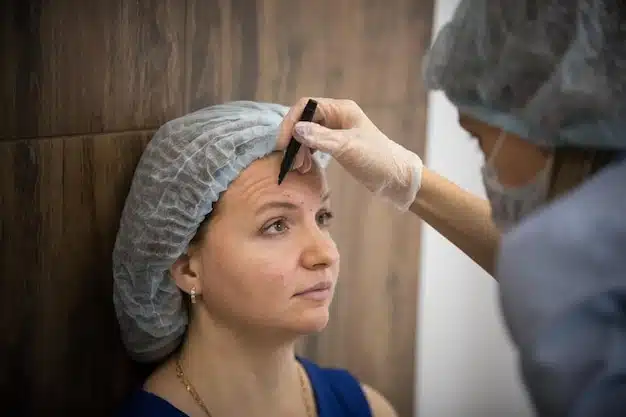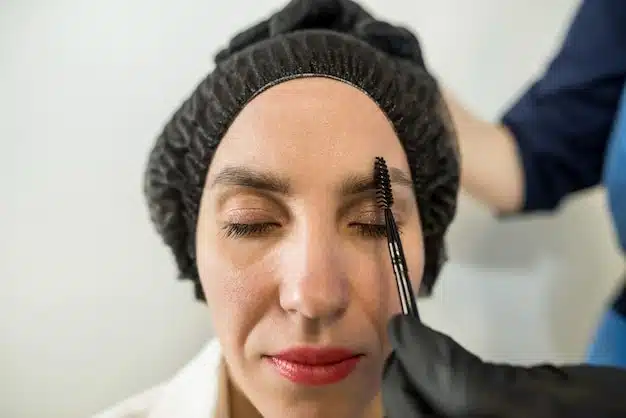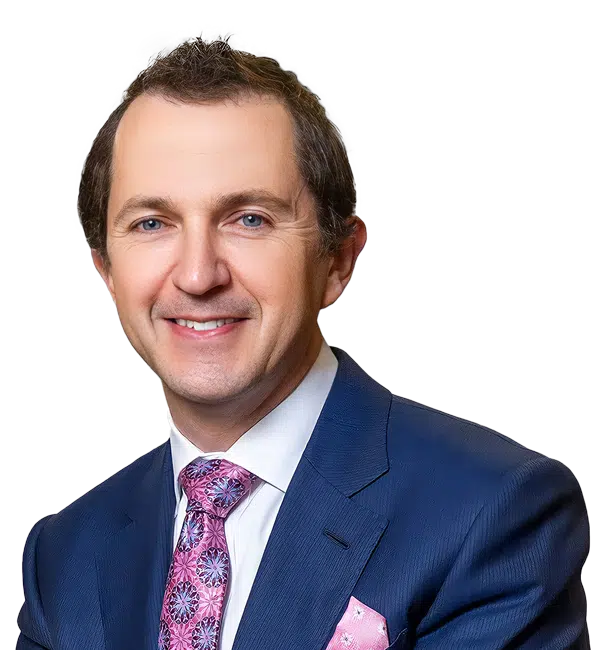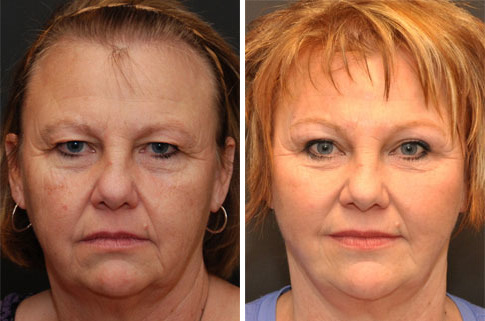An endoscopic brow lift is a cosmetic surgery that refreshes the appearance of the forehead and the area above the eyes. The time after the surgery is crucial for ensuring that you get the desired look while reducing the risk of problems.
Dr. Alexander S. Donath, who specializes in facial plastic surgery, offers his knowledge on how to recover properly following the procedure. He combines medical know-how with useful tips to help patients heal smoothly and successfully.

Healing After Brow Lift Surgery
- After an endoscopic brow lift, bruising and swelling are common but typically subside within two weeks.
- Depending on the individual’s healing process, patients typically return to work and normal activities within 10 days post-surgery.
- Following post-operative care instructions, such as keeping the head elevated and avoiding strenuous activities, is vital for a smooth recovery.
- Complete recovery and the final results of the brow lift may take several months to become fully apparent.
- Complications are rare, but promptly contacting a healthcare provider if symptoms seem unusual is important for patient safety.
Navigating the Immediate Post-Operative Care After an Endoscopic Brow Lift
In pursuing a rejuvenated and youthful appearance, post-operative care following a brow lift, whether endoscopic, temporal, or traditional, is paramount. Immediately after surgery, within hours, strict adherence to activity limitations is crucial to protect the delicate healing tissues in the forehead region and upper eyelids. This entails refraining from vigorous exercise and minimizing facial expressions to prevent strain on surgical incisions. Proper head elevation aids in reducing swelling and promoting healing, contributing to shorter recovery times. While discomfort is common, prescribed pain medication helps manage pain levels and should be taken as directed for optimal recovery. Additionally, vigilance in adhering to post-surgery guidelines ensures that the healing process progresses smoothly, mitigating risks such as excessive swelling or potential complications. By prioritizing diligent care and following medical recommendations, individuals can expect satisfactory outcomes from their brow lift procedures, enhancing appearance and overall well-being.
The First Week of Recovery Following an Endoscopic Brow Lift Surgery
Proper care during the first week of recovery is crucial to a successful endoscopic brow lift surgery outcome.
Swelling and Bruising Management
Post-surgery, you may experience swelling as a natural healing response. Elevate your head, even while sleeping, and regularly use cold compresses to help reduce it. This also helps keep the eyebrows in an ideal position, preventing excessive fluid buildup. Bruising, particularly around the incisions and possibly around the eyelids, is common but usually diminishes over the week.
Incision Care and the Healing Process
Taking good care of your incisions is critical to avoid infections and promote healing. Keep any dressings provided dry and in place to safeguard the area. If there are temporary drains, manage them as instructed by your healthcare provider. Some numbness may be present, which should lessen as nerves regenerate.
Follow-Up Appointments and Sutures Removal
Stick to your follow-up appointments to ensure everything is healing as it should. These visits include removing any sutures that aren’t self-dissolving. Your healthcare provider will also check the state of your eyebrows and offer further advice if needed.
Handling the aftercare as recommended can greatly influence the quality of your endoscopic brow lift recovery.
Short-Term Recovery Considerations After an Endoscopic Brow Lift
Identifying Normal Symptoms and Signs of Complications
After a brow lift procedure, it is normal to have swelling, mild discomfort, and bruising. These symptoms should improve within the first week. Be alert for signs of complications such as severe pain, uneven brow positioning, or infection signs like increased redness or discharge, and seek medical advice if these occur.
Adjusting to Daily Activities
Post-surgery, it’s important to resume activities gradually. Refrain from intense exercise or heavy lifting. Instead, take short walks to aid circulation and keep your head raised when resting to minimize swelling. Your surgeon will provide tailored recovery considerations, which may differ depending on the specific types of brow lift performed.
Understanding the recovery process is important in plastic surgery, including eyebrow lift surgeries. For a successful outcome, it’s important to monitor your body’s healing and follow the advice given by your healthcare provider.
Remember, different types of brow lift and individual patient factors can influence the short-term recovery process.
Sustaining Long-Term Healing and Care Post Endoscopic Brow Lift

After undergoing a plastic brow lift to achieve a more youthful appearance, proper care during the recovery period is essential for optimal results. This outpatient procedure typically involves surgical incisions in the forehead region, necessitating meticulous attention to healing and scar management. In the hours and days following surgery, prescribed pain medication helps manage discomfort, while avoiding vigorous exercise and ensuring cleanliness around the incision sites aid in proper healing. Patients should also disclose their medical history to their healthcare provider to mitigate potential complications.
Patients should diligently follow post-surgery instructions in the weeks and months following the procedure, including applying moisturizer to incision sites to promote elasticity and utilizing silicone sheets or gel for scar maturation. Routine check-ups allow healthcare providers to monitor progress and address any concerns promptly. Sun protection is crucial to safeguard delicate skin and minimize scarring, emphasizing the importance of daily sunscreen application and seeking shade during intense sunlight exposure. With consistent care and patience, individuals can anticipate gradual improvement in brow position and ultimately achieve the lasting benefits of this cosmetic procedure.
Essential Tips for a Smooth Recovery After an Endoscopic Brow Lift Procedure
Diet and Nutrition
A balanced diet supports your body’s healing ability after an endoscopic brow lift procedure. Protein is essential for tissue repair, and vitamins C and A promote healing. Drinking water often is important as it helps remove toxins and reduces swelling. A low sodium intake can prevent fluid retention. It’s important to adhere to your provider’s diet and nutrition guidance, especially since medications may influence your dietary choices.
Recovery tips for eating include:
- Choosing lean proteins
- Eating fruits and vegetables that are high in antioxidants
- Opting for whole grains
- Selecting low-sodium foods to prevent swelling
Physical Activity
Carefully reintroducing physical activity is part of the exercise recommendations during your recovery. Initially, prioritize rest to prevent any complications. Once your provider approves, try gentle walking to improve circulation and decrease the chance of blood clots, contributing to a smooth recovery. Steer clear of demanding exercises that may elevate blood pressure for a duration specified by your provider. Regular check-ins with your provider are crucial to get personalized advice on maintaining your well-being without jeopardizing the results of your surgery.
Discuss any concerns regarding medications and how they may affect your diet and exercise regimen with your provider.

Navigating Potential Risks Following Endoscopic Brow Lift Surgery
Ensuring a smooth recovery post-endoscopic forehead lift is crucial for achieving a youthful appearance without complications. Understanding potential risks and complications, such as reactions to anesthesia or swelling at the incision site, empowers individuals to monitor their healing process effectively. Prompt communication with healthcare providers is essential for addressing any concerning symptoms, including severe pain or vision changes, ensuring timely intervention if necessary. Embracing preventative measures, such as following prescribed pain medication, adhering to recovery guidelines, and avoiding strenuous activities, significantly reduces the risk of postoperative complications and promotes optimal healing of the forehead region. By actively participating in their recovery journey and maintaining open communication with healthcare providers, individuals can confidently navigate the recovery process and achieve desired cosmetic outcomes.
Setting Realistic Expectations for the Following Months After an Endoscopic Brow Lift
Appearance Changes and Recovery Process
In the days after surgery, it’s important to have realistic expectations for the appearance changes in the following months. As recovery progresses, the initial swelling will decrease, and the full effects of the procedure will slowly become apparent, marking the road to patient satisfaction. It’s normal to notice differences during healing and patients should see these as part of the recovery process, not causes for concern.
Emotional Response During Recovery
The psychological impact of recovering from cosmetic surgery is considerable, often mixing excitement with moments of impatience. Having a strong support system and maintaining an open dialogue with the surgeon about any emotional changes can improve the overall experience and mental health during this period.
Long-Term Maintenance
After the days after surgery have passed, long-term maintenance is essential for sustaining the surgery’s results. A regular skincare routine and healthy habits are fundamental, and ongoing communication with the surgeon will ensure the care remains specific to the patient’s needs. This commitment is key to long-term patient satisfaction with their refreshed look.
If you’re considering an endoscopic brow lift and want expert advice, Dr. Alexander S. Donath is an internationally recognized facial plastic surgeon with extensive training and expertise. With his impressive background, including presentations at top international conferences and specialized fellowship training, Dr. Donath is well-equipped to provide exceptional care.
For personalized guidance and to ensure the best possible outcome, schedule a consultation with Dr. Donath. His commitment to achieving excellent results and dedication to his patients’ needs make him a trusted choice for your facial plastic surgery journey.


